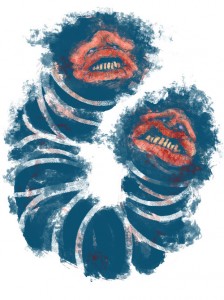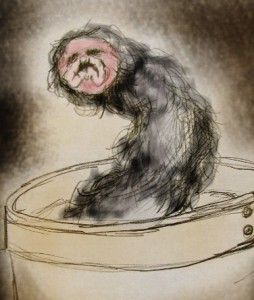Tilberi. Posted by hulda on Oct 15, 2012 in Icelandic culture, Icelandic history
 A notable thing about witchcraft in Iceland is that it used to be more common for men to practice it than women. Yet there is one Icelandic magical creature that could only be created by a woman – the tilberi.
A notable thing about witchcraft in Iceland is that it used to be more common for men to practice it than women. Yet there is one Icelandic magical creature that could only be created by a woman – the tilberi.
To make one she would have to dig up a dead body in secret and remove one of its rib bones. She would wrap it up in wool and hide the bundle between her breasts, and during the next three Sundays she would go to church but keep some of the holy wine from the communion in her mouth instead of swallowing it. This she would spit on the bundle. On the second time she did this it would stir and she had to make certain no one was able to see that, because creating a tilberi was naturally illegal, and witchcraft could be punishable by flogging or death.
The third time she would first grab the bundle tightly before spitting the wine on it, else the tilberi would jump out from her collar as it came alive. It considered the woman its mother; the owner would cut a nipple into her thigh from which it would feed. Whenever the tilberi was at home it would hide under her skirts, hanging from the extra nipple, growing all the while. This would cause its owner to develop a limp and eventually die as the supernatural “helper” would suck the life out of her.
Tilberi were very loyal to their house and would take orders as to whose sheep or cows it would or would not attack. It had two heads, one on each end, and it could drape itself across a sheep’s back to suck on two teats at the same time. When it eventually couldn’t drink more it would return home and say:
“Fullur beli, mamma.” (= Full belly, momma)
The owner would then let it throw up in the churn all the milk it had managed to steal. It’s said that the butter made out of tilberi-stolen milk is oddly soft and tastes strange, perhaps a little bit rancid even, and that it’ll disappear if a rune called Smjörhnútur (= butterknot) is drawn on top of it.
A similar creature to tilberi is a snakkur, identical in looks albeit a little bit bigger. It was made out of a larger bone, usually a leg bone, and it was used to steal wool and hay. Similarly to a tilberi it would eventually cause its owner’s death unless it were killed. The only way to kill a tilberi or a snakkur was to tell it to eat all the sheep droppings on three meadows’ area, and as they were eager to get back to the thigh nipple they’d eat so fast that they’d explode, leaving behind only a pile of dung, little bit of wool and a bone.
There’s an interesting new band over here now called Tilbury, by the way. They take their name after a short story by Þórarinn Eldjárn, Tilbury, and this video for their song Tenderloin might be quite interesting after reading about the tilberi and the snakkur*. Keep an eye out for suspicious activity while you watch it!
*Besides I really love their music.

Build vocabulary, practice pronunciation, and more with Transparent Language Online. Available anytime, anywhere, on any device.
About the Author: hulda
Hi, I'm Hulda, originally Finnish but now living in the suburbs of Reykjavík. I'm here to help you in any way I can if you're considering learning Icelandic. Nice to meet you!






Comments:
Christian Schoon:
Hey, Hulda. I’m a writer (American) researching Icelandic witchcraft. Your tilberi article is the just kind of thing I’m looking for: detailed info (in English) on how the witches/sorcerers conducted their rituals/cast their spells. I know most of these characters were male, but I’m more interested in what the females were up to. Any pointers on where to find more would be much appreciated. Cheers!
hulda:
@Christian Schoon Hello and nice to meet you! Thank you for the nice comment. 🙂
To find more about female Icelandic magic-users, tilberi and snakkur are good code words since they could only be made by women. For other female witches, Þuríður Ólafsdóttir is no doubt one of the most famous since she’s the only female witch ever executed by burning in Iceland. Her son claimed she could walk on water with the help of magical staves.
This is a difficult topic to research though… the witchcraft museum Strandagaldur might help: http://www.galdrasyning.is/index.php?lang=en